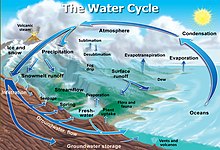Inflow (hydrology)
It has been suggested that this article be merged into Discharge (hydrology). (Discuss) Proposed since March 2021. |

In hydrology, the inflow is the water entering a body of water. It can also refer to the measure of average volume of incoming water per unit time. It is contrasted with outflow.
Overview[]
Inflow[1] is a process within the hydrologic cycle that helps maintain the water levels within all bodies of water.
All bodies of water have multiple inflows, but often, one inflow may predominate and be the largest source of water. However, in many cases, no single inflow will predominate and there will be multiple primary inflows. For a lake, the inflow may be a river or stream that flows into the lake. Inflow may also be, strictly speaking, not flows, but rather precipitation, like rain.
Inflow can also be used to refer to groundwater recharge.
Hydrologic Cycle[]
The hydrologic cycle,[2] or water cycle, has no true starting point. However, it’s easiest to start with the ocean, as the ocean makes up the majority of Earth’s water. The sun is the main aspect of the hydrologic cycle, as it is responsible for warming the water and causing evaporation. As water evaporates into the air and the rising air currents take the evaporated water into the atmosphere. Once the evaporated water reaches high enough in the atmosphere, it reaches cooler temperatures, which cause the vapor to condense into clouds.
Air currents are capable of moving clouds around the globe, but typically cloud particles collide and fall out of the sky as precipitation. Even though precipitation can fall in many forms and in many locations, most precipitations either ends up back into a body of water or on land as surface runoff.[3] A portion of runoff enters back into streams and rivers, which over time lead back to the ocean. Another portion of runoff soaks into the ground as groundwater seepage, and are stored in freshwater lakes.[4] The other portion of runoff soaks into the ground as infiltration, some of this water will infiltrate deep into the ground and replenish aquifers.[2]
Inflow and the Hydrologic Cycle[]
So how does inflow play a role in the hydrologic cycle? Inflow is the adding of water to the different aspects of the hydrologic system. Consequently, outflow is the removal of water from the hydrological cycle. Inflow adds water to different aspects of the hydrologic cycle that returns water storage to an even level. Water storage is the retention of water throughout different aspects of the hydrologic cycle. Due to the fact that water movement is cyclical,[5] inflow, outflow, and storage are all aspects of the hydrologic cycle.
Inflow = Outflow +/- Changes in Storage[5]
References[]
- ^ "The Hydrologic Cycle | Freshwater Inflows". www.freshwaterinflow.org. Retrieved 2020-12-09.
- ^ a b "Precipitation and the Water Cycle". www.usgs.gov. Retrieved 2020-12-09.
- ^ DOC, NOAA. "Description of the Hydrologic Cycle". www.nwrfc.noaa.gov. Retrieved 2020-12-09.
- ^ "Groundwater Flows Underground". www.usgs.gov. Retrieved 2020-12-09.
- ^ a b "Water Research Center - Watershed and Water Resource Budgets". water-research.net. Retrieved 2020-12-09.
External links[]
![]() The dictionary definition of inflow at Wiktionary
The dictionary definition of inflow at Wiktionary
- Hydrology
- Geography terminology stubs
